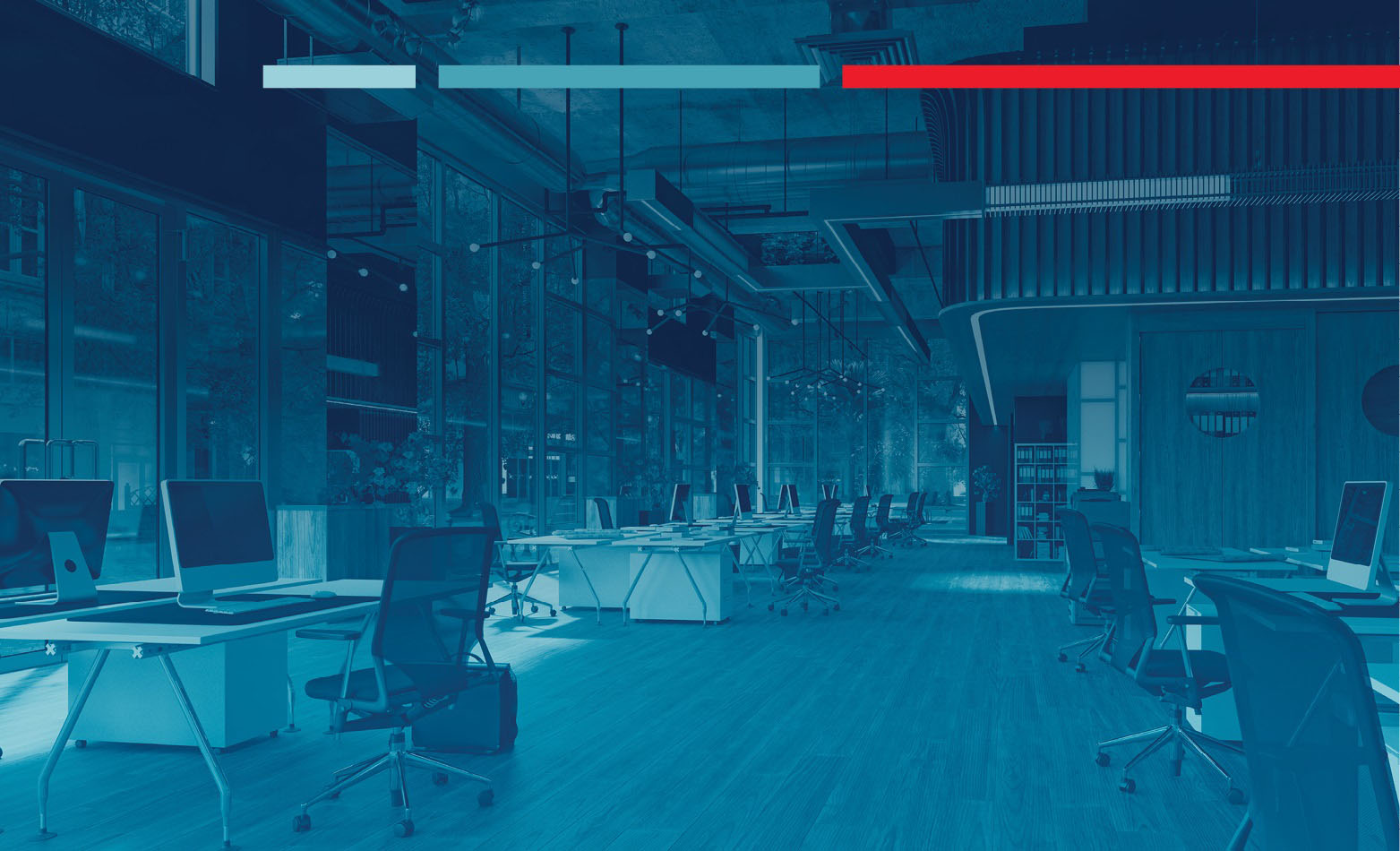

Insights
Which Amenities Are Driving Leasing Activity?
Flight to quality supercharged: Occupiers were already seeking out differentiated office space prior to the pandemic. In 2018 and 2019, 90% of office absorption was in Class-A buildings, accounting for approximately half of total inventory. This trend has accelerated since 2020. While overall absorption has been negative since the beginning of the pandemic, there has been over 100 million square feet (msf) of positive absorption in the best and newest office buildings over that same time. In addition, the rent premium for new properties compared to the rest of Class-A has doubled compared to before the pandemic.
Rent Premiums for New Assets Expanded Since 2020
- Employee experience matters: While some companies have mandated employee attendance, our research has shown that the most engaged workforces are those with autonomy over when and where they work. In flexible and hybrid workplace ecosystems, employers want to create engaging, experiential office environments where their employees will find value in attending the office in person several days a week. This includes quality of space, level of services provided, vibrancy of the surrounding neighborhood, and variety of amenities in and around the building. Property Owners are responding. Across the buildings1 analyzed in this report the 12 office buildings delivered or renovated since the beginning of 2020 have a larger array of amenities: these buildings average 17 different amenities versus the average of 14 across the entire building set.
- Amenities aren’t THE solution, but they play a critical role: Employees across industries view the purpose of the office similarly—to be with other people. The top reasons employees go to the office are for socialization, collaboration, work-life balance, access to tools and connection to the company. Amenities can be one solution to support the in-office employee experience. In this report we explore the most common amenities in locations where occupiers have recently signed large leases. These amenities cross several categories:
- Activation: Amenities that energize spaces for experience, collaboration and socialization.
- Convenience: Amenities that support employees in their full and busy lives.
- Commute: Amenities that make commuting easier, including parking or public transit proximity.
- Wellness: Amenities that support ESG and wellness initiatives around inclusion, health, sustainability, etc.
- Security: Amenities that provide safety and security for occupiers.
- Technology: Amenities that incorporate technology infrastructure such as tenant experience apps.
- Which amenities are moving the needle right now? Leading companies are attracted to buildings with a variety of available amenities—in other words, no one (or two) amenities will change a building’s narrative. Across the buildings analyzed, the average was 14 amenities in each one, with 10 buildings having more than 18 (out of 27 amenities tracked). The most common amenities are widespread, with five being available in more than 80% of tracked buildings: controlled access, on-site retail and food, fiber availability, nearby public transit, and on-site parking. Beyond those staples, occupiers are attracted to buildings with a selection of amenities that activate the space, offer convenience and elevate employee wellness.
Most Common Amenities Overall
Which Amenities Are Relevant?
The idea of flight to quality is broadly understood as the driver of office demand over the past few years. But what does that mean beyond new construction (or newly refurbished)? When Class-A buildings increasingly have every bell and whistle imaginable, what are the key building amenities that occupiers are looking for right now? By looking at the largest office leases in 2022, Cushman & Wakefield has identified the building amenities that are present where deals have been made, even in these uncertain times. Fifty buildings were analyzed and 27 distinct amenities in seven different categories were identified and catalogued in order to answer these pressing questions. For a full review of the methodology, visit the report appendix.
Most Common Amenities by Category
Convenience of access is critical. Among the top five most common amenities, with 80% of buildings qualifying, are both on-site parking and access to public transportation within two blocks. This indicates two critical things. First, getting to and from work as easily as possible is as important as ever. The highest barrier to employees returning to the office is the commute,2 which means that buildings that are located to ease this burden are more attractive to the largest occupiers. Second, even though public transportation usage remains below pre-pandemic levels, employers, employers know that some portion of their staff will be in the office more frequently if public transit is seamless and less stressful. Of course, this will be truer in Central Business Districts (CBDs) and markets with more built-out transit networks, but commute ease is vital in all markets and submarkets.
Intangible base needs. Two of the top three most common amenities are not physical in nature but are critical to employees’ physical safety and productivity: controlled access (86%) and fiber availability (84%). Not surprisingly, occupiers want to be in buildings where their people will feel safe and secure—base needs for psychological wellbeing. In addition, productivity in the office needs to be equivalent—if not better—than working from home, which is why fiber connectivity is becoming more common. How many of us have come into the office only to find that the technology and connectivity is worse than our home office? Given that access to tools is a top reason for employees to come into the office, these glitches are an unacceptable reality that property owners and tenants are focused on fixing.
Wellness is the new amenity. Employees with high levels of wellbeing are 2 1/2 times more likely to say they can do their best work at their job, compared to their peers with low wellbeing.3 Occupiers are increasingly focused on optimizing mental, physical, environmental and organizational health. Over half of buildings in the study are LEED certified, with a slightly higher proportion in CBDs (58%) than in the suburbs (46%). Wellness ratings are less common currently, with 22% of surveyed properties being WELL certified and 18% Fitwel certified. Most buildings also have other physical attributes that can support employee wellness: on-site fitness center (72%), outdoor space (70%), shower and lockers (64%), and bicycle storage (60%).
Accelerating Trends in Wellbeing
Experiential retail (and food) rules. Eighty-six percent of analyzed buildings had some mix of retail and food on-site. This is in line with pre-pandemic research that showed that highly amenitized buildings have a variety of food options in, adjacent to or within a half-mile of the building across different concepts and price points. Buildings most commonly have coffee shops, cafes and fast casual restaurant options in and adjacent to the building, but also offer access to some formal dining options, providing the opportunity to take a break throughout the day, grab a time- and cost-efficient lunch or host a pricier client meeting. Food and beverage amenities are ever evolving, becoming more personalized, instantaneous and convenient. In addition to traditional food options, there is growing use of on-site pop-up services, tech-friendly micromarkets, external deliveries, take-home meals and even cooking demos.
Activation and entertainment. As employers are more focused on bringing people back, it is important to have the spaces to support needs. Employees need experiences, such as special event, and socialization to be persuaded to come to the office. In addition to retail and food services on-site, half of buildings have on-site community managers focused on curating employee experiences. Fifty-eight percent of buildings have a tenant lounge that provides private space. This varies between buildings, but tenant lounges may resemble a hotel or airport lounge, connect to tenant conference areas, provide food and beverage services, or offer places to work or socialize. These lounges are even more common in new buildings, with 75% of buildings renovated in the last five years having a tenant lounge. In comparison, only 40% of buildings renovated between 2012 and 2018 have one. Lounges like this can serve as a social hub for the building, and for smaller tenants they can help offset the costs of building employee gathering spaces. Furthermore, these lounges in multi-tenant buildings can serve as places to cross-pollinate ideas and help employees from different companies gather and feel more connected.
How Does Amenity Demand Vary between CBD and Suburban Locations?
The demand for amenities is consistent, whether occupiers are looking to make substantial lease commitments in the suburbs or in a CBD. The concentration and variety of amenities is similar with buildings in each submarket type, falling between 13 and 14 amenities per building on average. In both locations, on-site parking and retail or food options are top five common amenities. Also, most buildings in both the CBD and suburbs have fiber availability, on-site fitness centers, common areas and conference centers, outdoor courtyards or plazas, as well as shower facilities.
The most glaring—and potentially least surprising—difference shows up with the commute. All suburban locations surveyed have on-site parking, while this is true of only 71% of urban buildings. The difference in the average Walk Score4 is nearly 50 points. The average CBD Walk Score of the buildings analyzed is 93. The CBD building with the lowest Walk Score is 47, which is above the suburban building set’s average—46. All suburban buildings have highway access within two blocks, and 89% of urban buildings are within two blocks of public transit options.
Amenity Prevalence: CBD vs Suburban Submarkets
Comparison of Walk Scores Between CBD & Suburbs
This report’s findings are not meant to imply that by simply building amenities, occupiers’ problems with engagement and attendance will be solved. What the team found interesting is that the amenities that make up recent flight to quality include the variety of experiences that provide convenience, activation, security, ease for commutes and technology. If occupiers have a choice between a building with high-quality amenities and one with fewer or lower-quality amenities, the choice would be clear.
This report provides a high-level snapshot to support occupiers with real estate decisions that will impact their business and the wellbeing of their employees. It is important to know that what may work for one occupier may not work for all. Decisions should be made based on which amenities are most important to individual occupiers, including their specific needs, culture, leadership goals and feedback from employees.

The team started with the largest office leases (by rentable square footage) over 12 months in 2022. We selected 50 leases for this analysis, all of which met the following criteria:
- Multi-tenant office buildings
- Flight to quality positioned asset (based on CoStar, flyers, websites and local market intel)
What did not meet the criteria for analysis:
- Single-tenant and owner-occupied buildings were removed, as data may be skewed based on company-specific requirements, driving negotiations and decisions
- Assets that were selected based on lower-cost priorities, based on market intel
- Assets where all data could not be validated by property manager, asset manager or local broker
What Markets Were included?
Buildings in 15 markets were included in this analysis. Within the markets, the submarkets were classified as urban or suburban to review commute-related amenities. as this is a frequently cited complaint about returning to the office. It is important to note that some cities may have both urban- and suburban-classified properties, such as Houston and Dallas.
When reviewing the selected assets, there were specific amenities viewed as outliers that would be hard to analyze across markets. Examples include outdoor ice-skating rinks, whiskey lounges, winter gardens, on-site tutoring or music rooms. These amenities were included as part of relevant overarching categories (e.g., outdoor space, retail space, etc.). As such, 27 building amenities were identified and allocated to the appropriate category or categories as noted above.5
Urban Top Amenities
Suburban Top Amenities
Acknowledgement
Thank you to the additional contributors for this project, including Elisa Konik, Catherine Tourigny, Samantha Sannella, Prianka Patel, Simon Newman and Nikhil Dua.
1 The 50 buildings included in the analysis were multi-tenant offices where the largest leases were signed in 2022. More information about the methodology is included in the appendix.
2 Cushman & Wakefield Experience Per Square Foot™ survey, results from October 1, 2020 – May 13, 2022, n=34,695
3 Source: Cushman & Wakefield Experience per Square Foot™ survey, results from October 1, 2020 – June 15, 2022, n=35,788 *high wellbeing includes respondents who reported “good,” “very good,” or “excellent” wellbeing. Low wellbeing includes respondents who reported “poor,” “very poor,” or “terrible” wellbeing.
4 https://www.walkscore.com/ External Link
5 A single amenity could be included in multiple categories because it meets a variety of needs. For example, an onside fitness center is a convenience feature but also offers wellness benefits.
Related Insights

Insights • Workplace
Obsolescence Equals Opportunity

Research • Workplace
Flexible Office is a Powerful Part of Your Workplace Strategy

Article • Workplace
Five Fast Facts: Return to Office